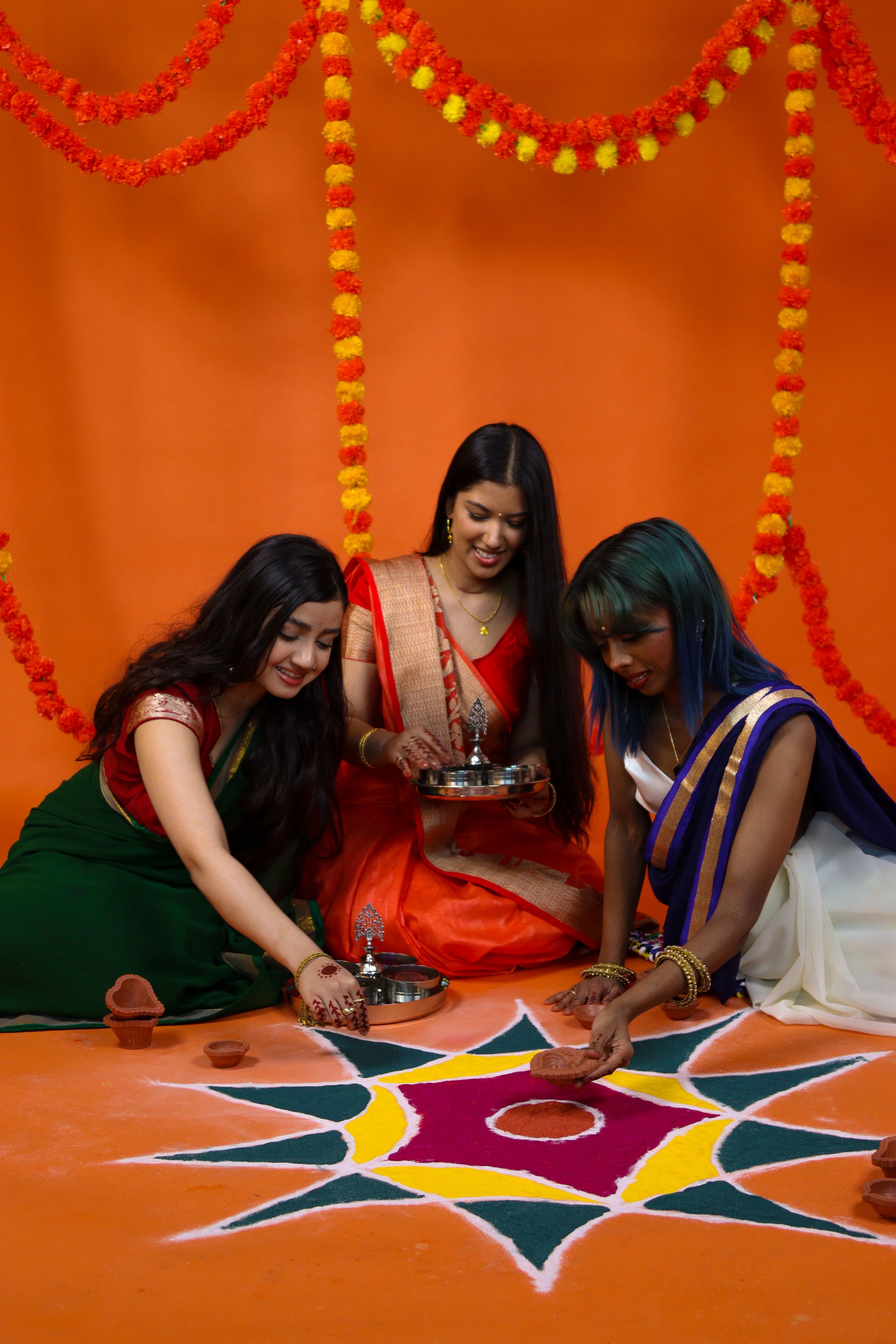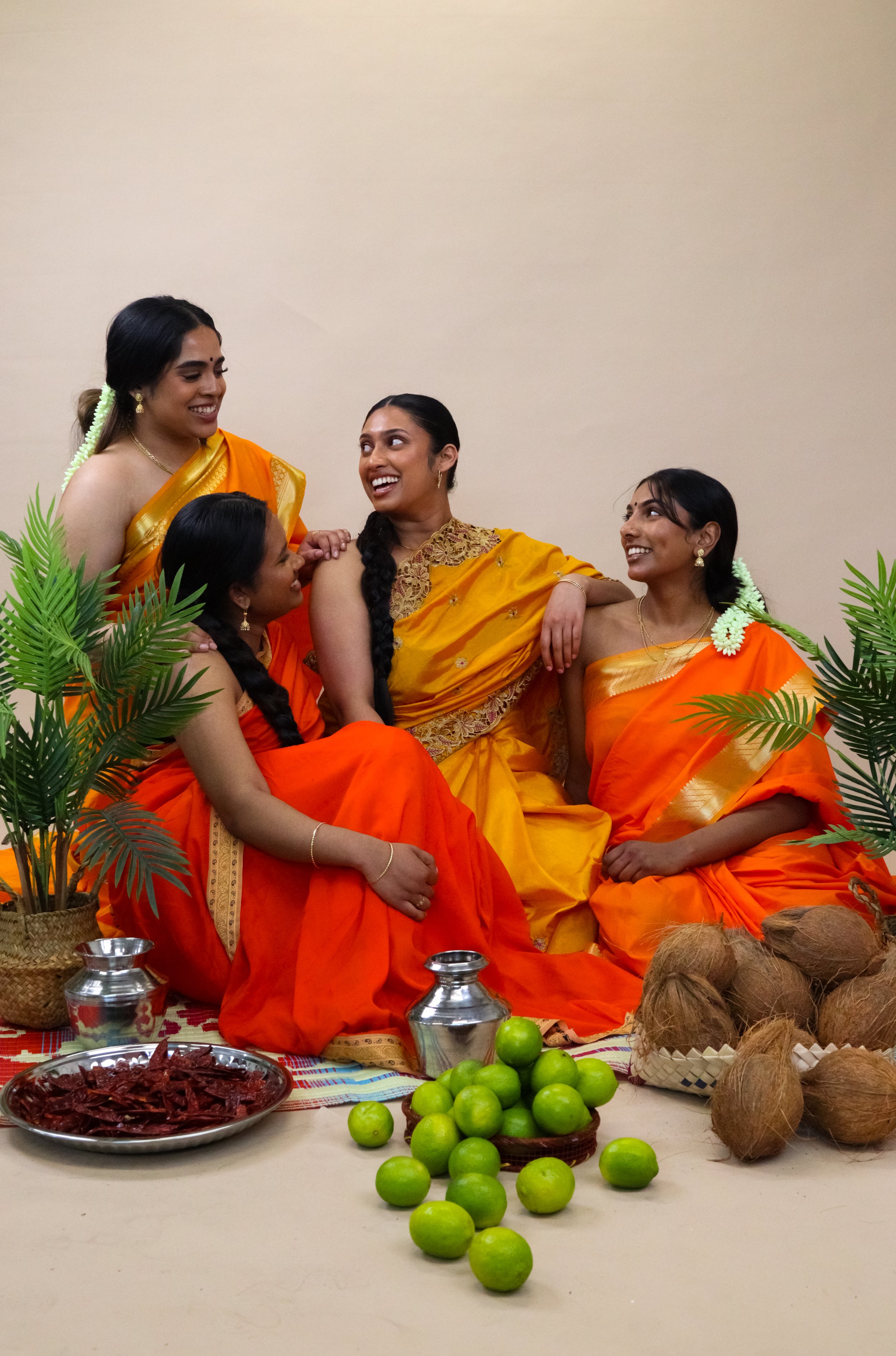"Not just Brown, not just Indian" with Mathushaa Sagthidas
/Photography - Mathushaa Sagthidas, Art Direction - Suprina Thapa, Styling & Make Up - namuna, Models - Suprina Thapa, Namuna, Reeya Darnal, Ronisha Darnal, Rojina Darnal
Terminology that defines us as people of colour, tends to a lot of the time alienate whole groups within a box. When we say South Asian, who do we mean? Does Indian involve everyone who identifies as such? Who are we missing and forgetting?
A London based freelance photographer Mathushaa Sagthidas released a project called Not just Brown, not just Indian, to show us who we are forgetting. Most of her work examines her identity as a Tamil Eelam woman, with British nationality.
“This project was created out of frustration from the lack of representation of South Asians from an authentic perspective within publications and gallery spaces” Mathushaa tells me, “Studying creative subjects meant that there was an educational structure that I had to follow, which involved having to including gallery references but many of the only references I could find at this time was of only stolen artefacts that resembled religious deities – despite our culture being more than about religion. To see stories from the lived experiences of south Asians would not only be relatable to some extent but it would mean so much to our south Asian communities in London (a city that does use diversity as a selling point).”
With this project, Mathushaa photographed women from regions of South Asia, to demonstrate what is missing in these narratives. For India, she focused on the celebration of Holi, by using Rangoli patterns and models in celebration dresses. She explains the use of rangoli, “The rangoli represents the happiness, positivity and liveliness of a household, and is intended to welcome Lakshmi, the goddess of wealth and good luck.”
Photography - Mathushaa Sagthidas, Art Direction - Radhika Muthanna, Styling - Aaishah Perager, Make Up - Karishma Leckraz, Models - Karishma Leckraz, Ravji aka Shaw, Aaliya Choudhury, Weave pieces - Sapna Patel
With Afghanistan, she looked used cousins to create a familial tone, showing a celebration of love by focusing on their childhood together and close relationship through matching dresses. They recreated memorable moments from their childhood - such as having tea, chatting or even dancing.
Photography - Mathushaa Sagthidas, Art Direction & Styling - Haida Hamidi, Make Up - Saida Hosseini, Models - Faria, Susan Sherifi, Farhat, Adria.
Nepal showcased sisterhood but also the importance of caste in their culture - in this instance, she used traditional wear to reflect the caste their families are from. Nepalese are known by castes amongst themselves essentially for their identity. It affects their family life, food, dress, occupations and culture.
Photography - Mathushaa Sagthidas, Art Direction - Suprina Thapa, Styling & Make Up - Namuna, Models - Suprina Thapa, Namuna, Reeya Darnal, Ronisha Darnal, Rojina Darnal
Sri Lanka/Tamil Eelam focuses more on the history of grandmothers and the lifestyle they had back home, whilst highlighting the beautiful but key differences and similarities between Tamil and Sinhala culture. Such as the difference in sari styles/design but the value of wearing warm tone saris for both communities. The other being what gold jewellery means to us - as the Sinhala women only wear one very significant and long chain, whereas Tamils tend to wear a few essential and religious pieces.
Photography - Mathushaa Sagthidas, Art Direction Peonica Fernando, Styling/ Draping for Sinhalese Models - Sahani Gunasekara, Styling/ Draping for Tamil Models - Keerthana, Make Up - Rebecca Raveendran, Tamil Models - Rebecca Raveendran, Pree, Sinhala Models - Nirodha Perera, Lourdes Navo.
With Bangladesh, we see a celebration of their New Year - Pôhela Boishakh, which is celebrated on 14 April in Bangladesh and 15 April in the Indian states of West Bengal, Tripura, and Assam by Bengalis regardless of religious faith. The importance of visiting family and friends, new year salutation and wearing Red-White Attire is essential.
Photography - Mathushaa Sagthidas, Art Direction - Waheeda Rahman-Mair, Asa, Styling - Asa, Make up - Inayah Zakir, Models - Waheeda Rahman-Mair, Asa, Maria Kayum, Tarrine Khanom.
Pakistan focuses on beauty traditions such as hair oiling, for deep conditioning of the roots and tips of their hair, which leave a thick and shining hair as a result and wearing surma (kohl eyeliner), which is thought to be a natural beauty hack that does not just soothe the tired eyes or keeps eye infections away but also makes women look more beautiful with bigger, and more accentuated eyes.
Photography - Mathushaa Sagthidas, Art Direction & Styling - Marni Syed, Marium Jeelani, Make Up - Marium Jeelani, Models - Marium Jeelani, Bismah Saleem, Hena, Henna on Bismah Saleem - Abidaa.
“With this project I want people to see more of South Asia from someone with lived experience within the culture. Growing up and especially when I was studying, I didn’t find many art pieces revolving around South Asian history and culture besides India within museum and gallery spaces”, Mathushaa tells me. She continues, “If I did it was often artwork and artefacts that had been stolen during British colonisation, which is one of the reasons that inspired me to create this project because I was so sick and tired of seeing only stolen south Asian artefacts but no references from a genuine perspective of someone South Asian.”
It's important that stories are told by us, otherwise we will question how genuine they are. When we look at our history, and go through archives, most of what we find is written by colonisers. And many people from South Asian backgrounds are unnamed. So finding people with the right backgrounds to reflect this is important too.
“When I went about selecting women for this project, I started off by doing a call out on Instagram (a platform I feel most creatives use to find other creatives) as well as eventually reaching out to Asian women I've already worked with. But I tried to keep this to a minimum because I wanted to use this opportunity to connect with more women across the UK. It was also with the help of some of the selected creatives who put forward other South Asian talent they knew for different concepts and countries.”
It's difficult to find people to represent cultures, when the representation is so minimal already, but with funding and enthusiasm, Mathushaa managed to get the right teams to showcase their cultures.
“It was a very cool process when it came to building the themes because I really wanted to create the concept based on family stories and histories, that had authentic and genuine representation. Not just something pretty, but something with meaning.”
When looking for her own representation, there aren’t many places Mathushaa felt seen, but she did mention @oru.mayil “[it] showcases the beauty of Tamil culture and the talent of various Tamil creatives across the world. For me, this was a key platform when I was studying and often used it for references. It was one of the very few platforms that had genuine stories revolving around Tamil heritage.”
Her final words to me summed up why this project meant so much to her, “I want people to learn. I want people to be curious, to understand and know that there is more to South Asia than just India. Growing up people would just assume that I was Indian, no one ever knew much about Sri Lanka let alone its history and you can say that about many of the other South Asian countries. I wanted to use this project to teach those who aren't so aware.”
Follow her on Instagram.














